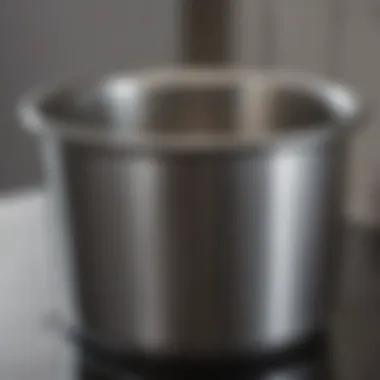Exploring the Market for Stainless Steel Pots


Intro
Stainless steel pots have carved a niche in both home kitchens and professional settings. Their sleek and shiny appearances, coupled with durability, make them a go-to option for many cooks and chefs alike. As homeowners and culinary enthusiasts gear up to buy new cookware, understanding the dynamics of the current market is essential. Pricing can vary significantly based on a range of factors, from the brand reputation to the quality of materials used. Being well-informed can save you both time and money.
When browsing through local retail stores or online platforms, you might observe various designs and features that specifically cater to diverse cooking styles. The allure of buying stainless steel pots during sales can lead to both excitement and confusion. To navigate through this immersive topic, we will explore design trends, practical tips, and delve into the intricate decision-making process involved in purchasing these kitchen staples.
Intro to Stainless Steel Cookware
Stainless steel cookware has become a staple in kitchens everywhere, thanks to its blend of functionality and durability. This article aims to illuminate the significance of stainless steel pots, focusing on their inherent qualities and how they cater to various cooking needs. It's essential to understand the different facets of stainless steel pots—from their materials to their designs—because these elements directly influence their performance in everyday use.
Defining Stainless Steel Pots
Stainless steel pots are vessels made primarily from steel that includes chromium, iron, and sometimes nickel. This combination offers resistance to rust and staining, which enhances their longevity. Unlike basic steel gear, which can wear down quickly, stainless steel pots maintain their appearance and performance even after years of use. Various manufacturers use different grades of stainless steel. For instance, 18/10 stainless steel contains 18% chromium and 10% nickel, providing both strength and corrosion resistance—ideal for anyone who loves to cook.
It's worth noting that stainless steel pots come in various shapes and sizes to suit specific cooking methods. You might find stock pots, saucepans, or even sauté pans with intricate designs and functionalities. Some are equipped with encapsulated bottoms, which ensure even heat distribution, crucial if you're serious about your culinary crafts.
Importance of Cookware in Culinary Arts
In the realm of culinary arts, the type of cookware can make or break a dish. Good quality stainless steel pots offer a multitude of benefits, particularly in terms of cooking efficiency and flavor preservation. Unlike other materials, stainless steel doesn't react with acidic foods, ensuring your sauces maintain their rich flavors without a metallic taste seeping in.
Furthermore, the durability of stainless steel ensures it withstands the rigors of busy kitchen life. They don't chip or crack as easily as non-stick options, making them an excellent long-term investment. For home cooks and professional chefs alike, having reliable cookware is akin to a painter having the right brushes—a non-negotiable necessity to achieve the desired results.
"Investing in quality cookware is investing in your culinary success."
Ultimately, understanding the ins and outs of stainless steel pots is essential for anyone serious about cooking. Not only do they offer remarkable benefits, but their robustness and versatility enhance overall cooking experiences, allowing chefs to focus on creating great meals.
Market Analysis of Stainless Steel Pots
Understanding the market for stainless steel pots is crucial for anyone looking to make informed decisions when buying cookware. This section will highlight current sales trends and the factors that shape consumer demand. By examining these elements, we can better understand how to navigate the often-complex marketplace.
Current Sales Trends
When venturing into the world of stainless steel pots, one can’t ignore the evolving sales trends that reflect modern culinary needs. In recent years, the demand for stainless steel cookware has been on a steady rise. Consumers are increasingly looking for durable, long-lasting options that don’t break the bank.**
Several key trends have emerged in the sales landscape of stainless steel pots:
- Growing Popularity of Online Shopping: As digital spaces expand, many buyers prefer online platforms for purchasing. Retailers like Amazon, Walmart, and specialty kitchen shops see a significant portion of their sales come from stainless steel cookware.
- Sustainability Consciousness: More shoppers are becoming eco-aware. Stainless steel pots fit this mold well due to their enduring nature, reducing the need for frequent replacements.
- Influencer Impact: Social media plays a large role in shaping opinions on what to buy. Influencers on platforms like Instagram and TikTok often showcase luxurious meals cooked with stainless steel pots, making them alluring to home cooks.
- Promotions and Discounts: Retailers frequently run sales events where they offer discounts on select stainless steel items, especially around holidays or special shopping days. These promotions drive consumer interest and often lead to a spike in purchases.
Overall, understanding these trends is vital for homeowners, designers, and retailers alike as it reveals what's currently on people's wish lists.
Factors Influencing Consumer Demand
Diving a bit deeper, several influencing factors emerge that determine why someone may choose a stainless steel pot over others. Factors to consider include:
- Quality vs. Price: Consumers typically weigh the trade-off between price and quality. While some may flinch at higher prices, many recognize that investing in a solid stainless steel pot can save money in the long run as they are less prone to damage and wear.
- Cooking Habits: A person’s cooking habits can significantly influence their choice. Those who love hosts and elaborate meals may gravitate towards larger, professional-grade pots, while everyday home cooks may opt for versatile, smaller sizes.
- Brand Reputation: Consumers are often swayed by brand loyalty or reputation. Well-known names like All-Clad or Cuisinart carry weight in the cookware world. Reliability in customer service and warranty options also plays a part in attracting buyers.
- Trendy Design Features: Aesthetics matter too. Stainless steel pots with modern designs and features, such as ergonomic handles or colorful accents, can attract attention in a crowded market.
"A smart buyer knows what they need in their kitchen, but understanding trends and demand ensures they don't end up with buyer's remorse."
Types of Stainless Steel Pots Available


Understanding the different types of stainless steel pots is crucial for anyone looking to make an informed purchase. This section aims to illuminate the various facets of stainless steel cookware, delving into its composition, the range of styles available, and how these can cater to specific cooking needs. Each type of pot possesses unique characteristics and potential applications, making it essential to discern which pots best align with your culinary practices. With the right knowledge, selecting suitable cookware becomes a seamless and rewarding experience.
Different Grades of Stainless Steel
When discussing stainless steel pots, one cannot overlook the significance of the grades of stainless steel. Often, the performance and durability of a pot depend heavily on its grade. Generally, stainless steel cookware falls into different categories—commonly 304, 316, and 430 grades. 304 stainless steel, for instance, is among the most versatile and resistant to rust and tarnish. This particular grade is often used in high-quality cooking vessels, favored by both home cooks and professional chefs.
On the other hand, 316 stainless steel boasts enhanced resistance to corrosion, making it perfect for those who often find themselves cooking with acidic ingredients. This grade is typically found in premium cookware, marketed towards serious culinary aficionados.
Meanwhile, 430 stainless steel is seen more in budget-friendly options. Although lighter and more susceptible to rust, it remains adequate for various cooking methods, especially for those who casually engage in home cooking.
Choosing the appropriate grade correlates directly with your cooking style and frequency. For those who frequently tackle rust-prone dishes or acidic preparations, investing in 304 or 316 grade pots might serve you better in the long run.
"The grade of stainless steel in your cookware can often determine its lifespan, versatility, and your overall cooking satisfaction."
Popular Pot Styles and Their Uses
Diving deeper into the types of stainless steel pots, various styles come into play. Each pot style is engineered with unique design specifications to maximize functionality in the kitchen. For example, stock pots are excellent for making large batches of soup or boiling pasta. Their tall, slender shape allows for efficient heating and cooking of large quantities.
Then, we have saucepans, which are perfect for simmering sauces or boiling grains. These pots typically come with a lid, allowing one to cover and trap moisture, which is particularly useful when preparing sauces or cooking rice
Saute pans, akin to frying pans but often deeper, offer versatility for browning foods or even simmering. The wide surface area makes flipping and turning ingredients much easier, providing an excellent platform for achieving that perfect sear!
Lastly, a dutch oven is an essential powerhouse for slow cooking. This heavy-bottomed pot retains heat splendidly, making it suitable for braising or baking.
- Stock Pots: Ideal for boiling and large soupy meals.
- Saucepan: Great for sauces and liquids requiring controlled simmering.
- Saute Pan: A favorite for browning and cooking diverse dishes.
- Dutch Oven: Perfect for slow cooking.
Navigating through the various types and styles can empower both the novice and experienced cook. In combination with the right grade, this knowledge sets the stage for engaging in an enjoyable and efficient culinary experience.
Advantages of Stainless Steel Cookware
Stainless steel cookware has carved a significant niche in kitchens around the world, and for good reason. When you think about cooking, remember that the tools you use can influence not just the quality of your meals but also the time you spend in the kitchen. The advantages of stainless steel pots stretch far beyond their shiny appearance, balancing functionality, safety, and durability.
Durability and Longevity
When it comes to cooking tools, durability is key. Stainless steel is renowned for its resilience. A well-made stainless steel pot can withstand a lot of wear and tear, resisting rust and corrosion that might plague other materials. Unlike non-stick pans that can scratch and degrade over time, stainless steel can take a beating and still shine like new.
"Investing in quality stainless steel cookware is like putting money in the bank; it pays off in the long run."
Consider this: if you buy a cheaper pot, it might save you a few bucks upfront but discovering it's warped or peeling a year later can be disheartening. In contrast, a high-quality stainless steel pot can last decades with proper care.
Safety and Health Aspects
Food safety should be at the forefront when selecting your cooking tools. Stainless steel pots are non-reactive, meaning they won't leach chemicals or react with acidic foods like tomatoes or vinegar. This makes them a healthier option compared to aluminum or Teflon alternatives, which can pose health risks when heated or scratched.
Moreover, because they're typically dishwasher safe, cleaning is a breeze, reducing the chances of bacteria buildup that can occur in less durable surfaces. Keep in mind that if proper cleaning methods aren't followed, even trusted materials could let you down. So, treating your stainless steel pots well is paramount for optimal safety.
Heat Distribution and Cooking Performance
One of the less-discussed benefits of stainless steel cookware is its effective heat distribution. Good heat conduction leads to more even cooking, reducing the risk of hot spots that can lead to burnt or undercooked foods. A pot with a thicker base, often seen in quality stainless steel designs, helps regulate temperature better than thinner alternatives, which can lead to uneven cooking performance.


If you’re juggling multiple dishes or trying to achieve a complex culinary feat, having a reliable pot that keeps a consistent heat can be a game changer. You’ll find your cooking processes smoother, whether it’s simmering a sauce or boiling vegetables. Fresh meals often hinge on precise temperatures, after all.
End
The advantages of stainless steel cookware, particularly pots, are numerous and vary across durability to safety and performance. By investing in quality pots, you’re not just buying a cooking tool; you’re making a choice that leads to better meals and possibly a longer lifespan for your cookware. For homeowners, culinary enthusiasts, or anyone who enjoys cooking, these tools can make everyday meal preparation both enjoyable and efficient.
Considerations When Purchasing Stainless Steel Pots
When it comes to buying stainless steel pots, there are a multitude of factors to keep in mind. This guide will help to ensure that your purchase is not only wise but truly fulfilling in your culinary endeavors. From understanding the right sizing to identifying the brands that uphold quality, each aspect makes a significant impact on how you cook and serve your meals.
Size and Capacity Requirements
Understandably, the size of the pot plays a crucial role in cooking efficiency. A pot that’s too small can lead to disasters like spilling or uneven cooking. Conversely, a vessel that is too large might waste energy and space. Consider the number of people you usually cook for. If it’s just a couple of you, then a medium-sized pot should fit the bill just fine. However, for those header parties or family get-togethers, a larger pot is a must. Also, don't forget about the height versus width; a deeper pot might hold more, but it could be awkward while stirring.
"Choosing the right size can save not just effort but also ingredients!"
Budgeting for Quality and Value
Money matters, right? But it's not just about spending less; it’s about making your dollars work effectively. Stainless steel pots come in every price range. A less expensive pot might seem tempting, but skimping on quality could lead to quicker deterioration. Investing in well-known brands usually pays off in the long run, with better materials that last years longer.
Here are some points to keep in mind:
- Material Matters: Higher grades of stainless steel are often more expensive but worth the investment.
- Set vs. Individual Pieces: Sometimes buying a full set is cheaper than buying individual pots. However, ensure the set contains sizes you will use.
- Sales & Discounts: Keep an eye out for seasonal sales but never sacrifice quality for a short-term deal.
Identifying Reputable Brands
When you decide to make any purchase, particularly for cookware, brand reputation often speaks volumes. How do you know which brands to trust? Here’s how to tackle that:
- Research Reviews: Websites like Reddit or even dedicated cooking forums can give you insights from real users.
- Check Warranties: A strong warranty indicates that the brand stands behind its product.
- Ask for Recommendations: Friends, family, or even culinary professionals can steer you toward brands that deliver.
If you take the time to evaluate these considerations, you're not only ensuring that you buy a pot that meets your cooking needs but also supporting your kitchen with quality tools that inspire creativity and confidence. Make your choices wisely, and you'll find that your stainless steel pots enhance your culinary skills and make cooking a lot more enjoyable.
Evaluating Sales and Discounts
In the world of stainless steel cookware, understanding sales and discounts can make a significant difference for homeowners and culinary enthusiasts alike. It’s not merely about purchasing pots; it’s about maximizing the value of your investment. When you’re shopping for stainless steel pots, evaluating discounts can help you identify when you’re getting the best deals possible, helping to keep your budget in check while ensuring you get high-quality products that will last.
One of the most notable benefits of evaluating sales is the potential for considerable cost savings. Stainless steel pots can represent a considerable investment, particularly for those looking to build a robust kitchen ensemble. Therefore, being savvy about sales trends allows buyers to take advantage of price drops, seasonal sales, and promotional events—opportunities that shouldn’t be overlooked.
Key Considerations for Evaluating Sales:
- Seasonality: Sometimes, the timing of your purchase can affect the price significantly. For instance, many retailers have sales during holidays or specific seasons like spring cleaning or back-to-school weeks.
- Inventory Clearance: Keeping an eye on clearance events is another tactic. As stores look to make space for new inventory, marked-down prices on existing cookware sets can lead to fantastic finds.
- Online Sales: E-commerce platforms often hold exclusive sales, offering discounts that are not available in brick-and-mortar stores. Regularly checking these can save significant amounts over time.
In essence, understanding the intricacies behind sales and discounts provides a strategic advantage when you step into the cookware market.
Timing Your Purchase Strategically
Timing plays a crucial role in the decision-making process for many kitchenware purchases, especially stainless steel pots. Knowing when to buy can indeed lead to remarkable savings. Consider keeping abreast of seasonal promotions, like Black Friday or Cyber Monday, where cookware often sees steep cuts in price.
- End of Season Sales: Retailers often discount pots substantially at the end of a season to clear out stock. For example, fall might see discounts on items that have seen summer use as brands anticipate new seasonal designs to hit the shelves.
- Manufacturer Events: Pay attention to promotional events from cookware manufacturers. They sometimes offer direct discounts for their products, especially on special holidays or during anniversaries.
- Bundle Offers: Some retailers provide bundled offers to enhance sales. For instance, if you buy a set of pots, they might include a pan or utensil at a fraction of the price.


"Purchasing cookware isn't just about what’s shiny and new; it’s about the right timing to capitalize on savings."
Understanding Warranty and Return Policies
Navigating warranty and return policies is equally vital when assessing stainless steel pots. A solid warranty can be indicative of a manufacturer’s confidence in their product’s durability, and it ensures peace of mind with your purchase.
When purchasing cookware, look closely at the warranty details. Some brands offer lifetime warranties, which not only reflect quality but also save you money over time.
- What to Look For in Warranties:
- Length of coverage—does it last a lifetime or a specified number of years?
- What is covered—does it include issues like warping or discoloration?
Additionally, familiarize yourself with the return policies in case the pots do not meet your expectations. Some retailers extend generous return periods, while others may have stricter policies. This knowledge can significantly reduce the risk associated with your purchase.
Care and Maintenance of Stainless Steel Pots
Caring for stainless steel pots is not just a chore; it’s an investment in your culinary future. These pots, known for their durability and resilience, can last a lifetime with the right attention. To get the most out of your purchase, effective care and maintenance practices are essential. This section delves into the various methods to clean and maintain these pots as well as tackles common issues that might crop up.
Cleaning Techniques and Best Practices
Cleaning stainless steel pots can feel a bit like chasing your tail if not approached with the right techniques. While stainless steel is resistant to staining, it isn't stain-proof. Therefore, the goal is to keep pots pristine without scratching their surfaces. Here are some effective strategies:
- Immediate Cleaning: Wash your pots right after use. Leftover food can harden and become a nuisance. Have a warm, soapy water ready and give your pots a scrub as soon as possible.
- Using the Right Tools: Opt for non-abrasive sponges or cloths. Steel wool or scouring pads may scratch your pots, detracting from their shine.
- Baking Soda Paste: For stubborn stains, mix baking soda with water to form a paste. Apply it to the affected areas and let it sit for a while before rinsing off.
- Vinegar Rinse: After cleaning, a quick rinse with vinegar can restore the shine. It helps remove any residues that might have been left behind.
- Avoiding Discouraging Chemicals: High-acidic foods or harsh chemicals can diminish the quality of your cookware. Always check labels and avoid products not intended for stainless steel.
"A stitch in time saves nine—if you keep your pots clean, you won’t face bigger problems down the road."
Common Issues and Solutions
Even the sturdiest cookware can encounter obstacles. A proactive approach to potential issues will keep your pots looking and performing at their best. Here’s a look at some common issues and how to deal with them:
- Discoloration: After prolonged use and high-temperature cooking, pots might appear discolored. Avoid cooking acidic foods at high heat, as they are often the culprits. To rectify this, a paste of baking soda and water can be effective.
- Water Stains: Hard water can leave unsightly spots. Simply wiping your pots dry after washing will help prevent this. If stains persist, a vinegar soak can clear the way to a fresher look.
- Scratches: While it might be unavoidable, scratches can be minimized by using the right tools in the cleaning process. If scratches do appear, they can often be polished out using a specialized stainless steel cleaner.
- Warping: Rapid changes in temperature can lead to warping. Avoid putting a hot pot directly into cold water. Slow, even cooling helps maintain pot shape.
Proper care and attention can ensure that your stainless steel pots remain a staple in your kitchen for many years to come. By employing simple cleaning techniques and addressing common issues, you distinguish yourself as a conscientious owner who values quality and longevity in cookware.
End
In wrapping up this exploration of stainless steel pots, it’s essential to recognize how pivotal these versatile kitchen essentials are to both the casual cook and the culinary aficionado. While the article has meticulously detailed various aspects of stainless steel cookware, including its manufacturing processes and the numerous benefits it brings to the table, the conclusion serves as a holistic reminder of what makes these pots worth the investment.
Summarizing the Benefits of Stainless Steel Pots
Stainless steel pots shine brightly in the kitchen for several reasons. First off, their durability cannot be overstated. They resist warping, scratching, and corrosion like few other materials can, meaning that with proper care, they're likely to last a lifetime. Home cooks often rave about their heat conductivity; high-quality stainless steel pots distribute heat evenly, which is crucial when preparing authentic sauces or soups that need to simmer just right.
Moreover, there's the hygiene aspect to consider. Stainless steel offers a non-porous surface, which means that it won’t retain bacteria, odors, or flavors from previous meals, making them a favorite among health-conscious individuals. In addition, these pots are easy to clean and often dishwasher-safe, significantly reducing the hassle after a long day of cooking.
Lastly, their sleek appearance can add a touch of elegance to any kitchen space. They are not just tools but can be a beautiful part of your countertop decor.
"Investing in quality stainless steel cookware is investing in a healthier kitchen and a more enjoyable cooking experience."
Encouraging Informed Purchase Decisions
When it comes to investing in stainless steel pots, knowledge is truly power. It's vital for consumers to know what they’re looking for when making a purchase. This article outlined critical considerations such as size, capacity, and budget. Keeping these factors in mind ensures that you're not merely buying any pot off the shelf, but selecting the one that best meets your cooking needs.
Reputable brands deserve special mention here. One should not shy away from researching well-known manufacturers that have a track record in producing high-quality cookware. This can prevent buyers from falling into the trap of choosing less durable options that might look appealing but fall short in performance.
Finally, take your time to evaluate sales and discounts. Seasonal sales may offer significant savings, but it’s prudent to analyze whether the product matches your needs before diving into a purchase. Informed decisions can transform a standard kitchen into a sanctuary of culinary creativity.







